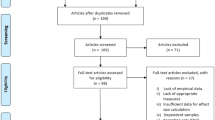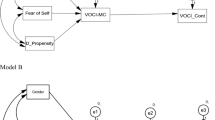Abstract
Looming vulnerability is a cognitive vulnerability for anxiety syndromes that pertains to a tendency to construct dynamic expectations (i.e., mental scenarios) of negative events as progressively increasing in danger and rapidly escalating in risk. The present study tested the hypothesis that looming vulnerability to contamination (i.e., looming of contamination) and generalized looming vulnerability would be positively related to contamination fears commonly observed in obsessive compulsive disorder (OCD) even when controlling for other vulnerabilities such as negative affectivity, anxiety sensitivity, and appraisals of potential for harm. The results support the predictions that both generalized looming vulnerability and looming of contamination are independently associated with contamination fears. Examination of the specificity of the ‘growing’ and ‘spreading’ aspects of contamination looming revealed that these components did not independently predict contamination fears beyond the additional vulnerabilities, supporting the consideration of a total looming of contamination construct rather than independent examination of its components. The implications of these findings for the conceptualization and treatment of contamination-based OCD are discussed.
Similar content being viewed by others
References
Abramowitz, J. S., Whiteside, S., Lynam, D., & Kalsy, S. (2003). Is thought-action fusion specific to obsessive-compulsive disorder?: A mediating role of negative affect. Behaviour Research and Therapy, 41, 1069–1079.
Beck, A. T., & Clark, D. A. (1997). An information processing model of anxiety: Automatic and strategic processes. Behaviour Research and Therapy, 35, 49–58.
Burns, G. L., Keortge, S. G., Formea, G. M., & Sternberger, L. G. (1996). Revision of the Padua Inventory of obsessive compulsive disorder symptoms: Distinctions between worry, obsessions and compulsions. Behaviour Research and Therapy, 34, 163–173.
Cisler, J. M., Reardon, J. M., Williams, N. L., & Lohr, J. M. (2007). Anxiety sensitivity and disgust sensitivity interact to predict contamination fears. Personality and Individual Differences, 42, 935–946.
Dorfin, N. M., & Woody, S. R. (2006). Does threatening imagery sensitize distress during contaminant exposure? Behaviour Research and Therapy, 44, 395–413.
Hodgson, R. J., & Rachman, S. (1977). Obsessional-compulsive complaints. Behaviour Research and Therapy, 15, 389–395.
Leckman, J. F., Grice, D. E., Boardman, J., & Zhang, H. (1997). Symptoms of obsessive-compulsive disorder. American Journal of Psychiatry, 154, 911–917.
Muris, P., Merckelbach, H., Nederkoorn, S., Rassin, E., Candel, I., & Horselenberg, R. (2000). Disgust and psychopathological symptoms in a nonclinical sample. Personality and Individual Differences, 29, 1163–1167.
Norton, P. J., Sexton, K. A., Walker, J. R., & Norton, G. R. (2005). Hierarchical model of vulnerabilities for anxiety: Replication and extension with a clinical sample. Cognitive Behaviour Therapy, 34, 50–63.
Obsessive Compulsive Cognitions Working Group. (1997). Cognitive assessment of obsessive-compulsive disorder. Behaviour Research and Therapy, 35, 667–681.
Olatunji, B. O., Lohr, J. M., Sawchuk, C. N., & Tolin, D. F. (2007). Multimodal assessment of disgust in contamination-related obsessive-compulsive disorder. Behaviour Research and Therapy, 45, 263–276.
Olatunji, B. O., Sawchuk, C. N., Arrindell, W. A., & Lohr, J. M. (2005). Disgust sensitivity as a mediator of the sex differences in contamination fears. Personality and Individual Differences, 38, 713–722.
Peterson, R. A., & Heilbronner, R. L. (1987). The Anxiety Sensitivity Index: Construct validity and factor analytic structure. Journal of Anxiety Disorders, 1, 117–121.
Rachman, S. (1998). A cognitive theory of obsessions: Elaborations. Behaviour Research and Therapy, 36, 385–401.
Rachman, S. (2004). Fear of contamination. Behaviour Research and Therapy, 42, 1227–1255.
Rachman, S. (2007). Self-constructs in obsessive-compulsive disorder. Journal of Cognitive Psychotherapy: An International Quarterly, 21, 257–260.
Rasmussen, S. A., & Tsuang, M. T. (1986). Clinical characteristics and family history in DSM-III obsessive-compulsive disorder. American Journal of Psychiatry, 143, 317–322.
Reiss, S., Peterson, R. A., Gursky, D. M., & McNally, R. J. (1986). Anxiety sensitivity, anxiety frequency and the predictions of fearfulness. Behaviour Research and Therapy, 24, 1–8.
Riskind, J. H. (1997). Looming vulnerability to threat: A cognitive paradigm for anxiety. Behaviour Research and Therapy, 35(5), 386–404.
Riskind, J. H., Abreu, K., Strauss, M., & Holt, R. (1997a). Looming vulnerability to spreading contamination in subclinical OCD. Behaviour Research and Therapy, 35(5), 405–414.
Riskind, J. H., & Rector, N. A. (2007). Beyond belief: Incremental prediction of OCD by looming vulnerability illusions. Journal of Cognitive Psychotherapy, 21, 243–256.
Riskind, J. H., Tzur, D., Williams, N. L., Mann, B., & Shahar, G. (2007). Short-term predictive effects of the looming cognitive style on anxiety disorder symptoms under restrictive methodological conditions. Behaviour Research and Therapy, 45, 1765–1777.
Riskind, J. H., Wheeler, D. J., & Picerno, M. R. (1997b). Using mental imagery with subclinical OCD to “freeze” contamination in its place: Evidence for looming vulnerability theory. Behaviour Research and Therapy, 35, 757–768.
Riskind, J. H., & Williams, N. L. (2005). The looming cognitive style and generalized anxiety disorder: Distinctive danger schemas and cognitive phenomenology. Cognitive Therapy and Research, 29, 7–27.
Riskind, J. H., Williams, N. L., Gessner, T., Chrosniak, L. D., & Cortina, J. (2000). The looming maladaptive style: Anxiety, danger, and schematic processing. Journal of Personality and Social Psychology, 79, 837–852.
Salkovskis, P. M. (1999). Understanding and treating obsessive-compulsive disorder. Behaviour Research and Therapy, 37, S29–S52.
Soares, J. J., & Ohman, A. (1993). Preattentive processing, preparedness, and phobias: Effects of instruction on conditioned electrodermal responses to masked and non-masked fear-relevant stimuli. Behaviour Research and Therapy, 31, 87–95.
Stekette, G. S., Grayson, J. B., & Foa, E. B. (1985). Obsessive-compulsive disorder: Differences between washers and checkers. Behaviour Research and Therapy, 23, 197–201.
Telch, M. J., Shermis, M. D., & Lucas, J. A. (1989). Anxiety sensitivity: Unitary personality trait or domain-specific appraisals? Journal of Anxiety Disorders, 3, 25–32.
Tolin, D. F., Worhunsky, P., & Maltby, N. (2004). Sympathetic magic in contamination-related OCD. Journal of Behavior Therapy and Experimental Psychiatry, 35, 193–205.
Watson, D., Clark, L. A., & Tellegen, A. (1988). Development and validation of brief measures of positive and negative affect: The PANAS scales. Journal of Personality and Social Psychology, 54, 1063–1070.
Williams, N. L., Olatunji, B. O., Elwood, L. S., Connolly, K. M., & Lohr, J. M. (2006). Cognitive vulnerability to disgust: Development and validation of the Looming of Disgust Questionnaire. Anxiety, Stress, and Coping, 19, 365–382.
Woody, S. R., & Tolin, D. F. (2002). The relationship between disgust sensitivity and avoidant behavior: Studies of clinical and nonclinical samples. Journal of Anxiety Disorders, 16, 543–559.
Author information
Authors and Affiliations
Corresponding author
Rights and permissions
About this article
Cite this article
Elwood, L.S., Riskind, J.H. & Olatunji, B.O. Looming Vulnerability: Incremental Validity of a Fearful Cognitive Distortion in Contamination Fears. Cogn Ther Res 35, 40–47 (2011). https://doi.org/10.1007/s10608-009-9277-3
Published:
Issue Date:
DOI: https://doi.org/10.1007/s10608-009-9277-3




